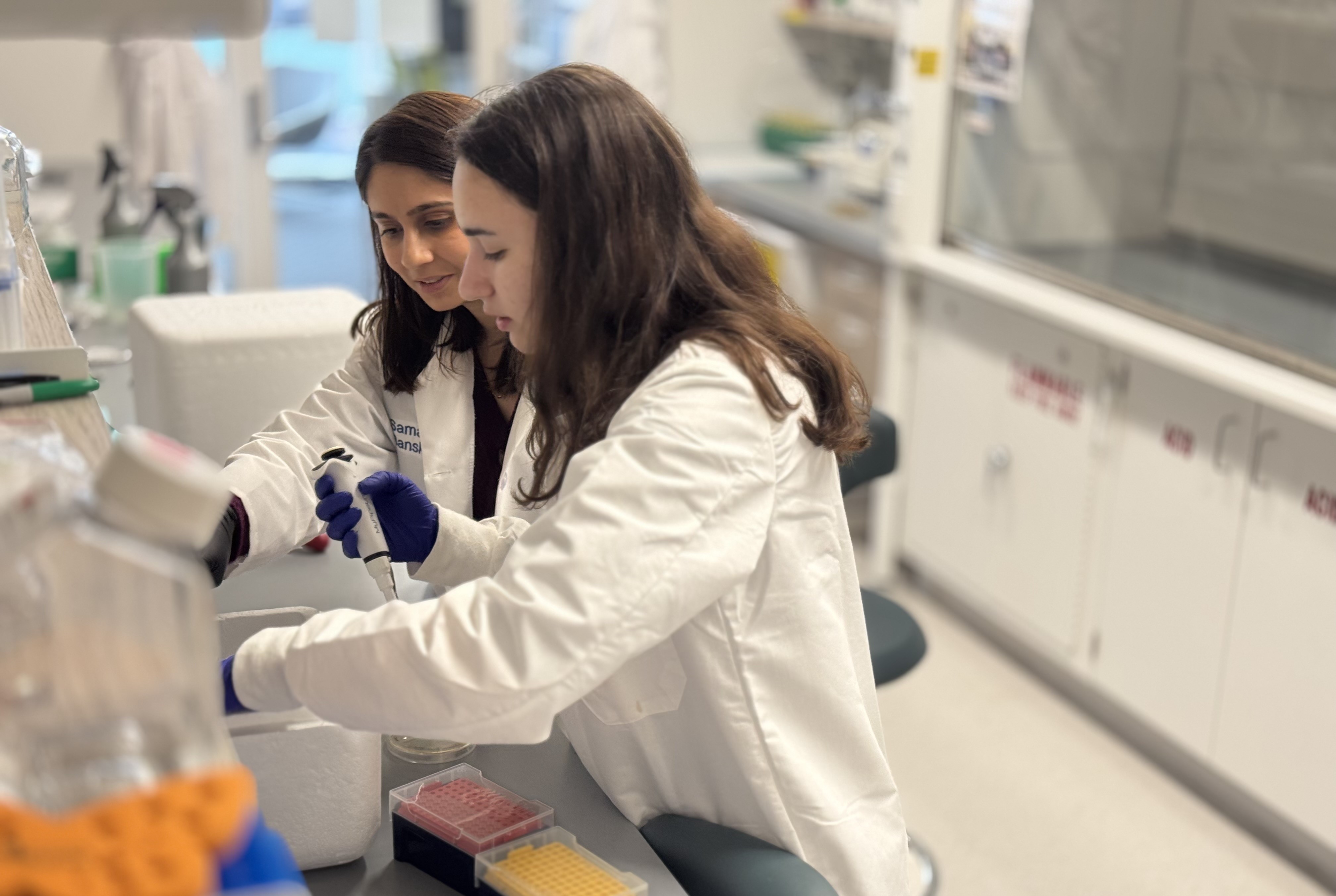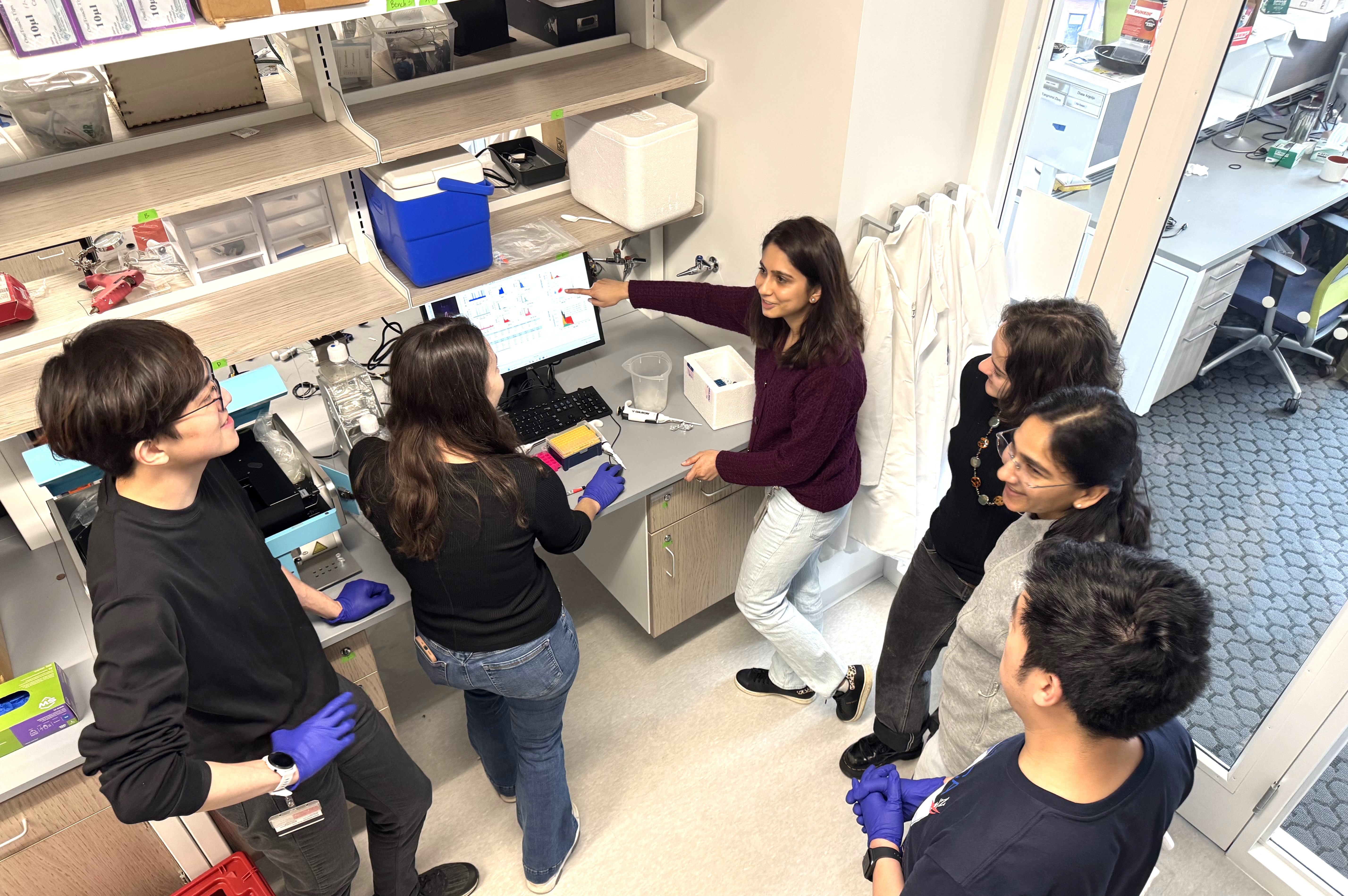Scientist Profile – Professor Samagya Banskota
Applying synthetic biology to advance cell and gene therapy
Samagya Banskota, Ph.D. – Assistant Professor of Biomedical Engineering
The Banskota Lab conducts research that combines expertise in biomaterials design, synthetic biology, drug delivery, and gene editing in order to better understand and treat diseases.
Professor Samagya Banskota (Biological Design Center) discussed her research improving delivery systems for genetic treatments, shared her journey toward biomedical research as a student in Nepal, and explained why she would like to have a certain time-based superpower.

How would you describe your research and the goals of your lab?
My lab works to translate genome-editing technologies into effective treatments for patients by better understanding barriers to in vivo (i.e. in a living organism) delivery. These technologies are designed to precisely correct mutations that cause diseases, which is especially important for people with rare genetic diseases who often have limited treatment options. The main challenge in developing these therapies is delivering them to the right tissues and cells within the body. Take sickle-cell anemia, for example, which is a genetic disease that affects the shape of red blood cells, causing some cells to take on a sickle or crescent moon shape instead of being round and flexible like healthy red blood cells. This abnormal shape restricts the cells’ ability to carry oxygen throughout the body. Sickle-cell disease can be extremely painful and lead to many health complications, and it’s caused by a single-letter misspelling in the hemoglobin gene. Our goal is to determine the most effective ways to deliver genome-editing technologies that could potentially cure diseases like sickle-cell anemia. Although genetic diseases are often considered “rare,” collectively they affect millions of people worldwide.
Can you provide examples of ways your lab advances these genome-editing treatments?
One way we improve genome-editing treatments is by creating delivery systems that make the treatments safer, more precise, and more versatile so that they may be applied to a broader range of biological and clinical challenges. To achieve this, we draw inspiration from natural delivery systems like circulating immune cells, viruses, and bacteria. Though we usually associate these systems with disease, they are also incredibly efficient carriers of macromolecular cargoes and have a great deal to teach us in terms of design. Over millions of years, they have evolved to package, protect, sense, and deliver different types of cargo, including RNA and DNA into specific cell types. By studying the biophysical and molecular mechanisms through which these systems sense and target specific tissues, evade immune detection, and enter cells, we aim to replicate or even improve upon these capabilities in synthetic delivery platforms. Essentially, we’re designing systems de novo (i.e., from scratch) that mimic or enhance nature’s strategies for delivering genome-editing components precisely where they are needed in the body.
In addition to delivery, our lab also develops diagnostic tools. For instance, we engineer systems using genome-editing technology like CRISPR to detect early biomarkers associated with genetic diseases, enabling earlier and more accurate diagnosis.
Can you go into some detail about your lab’s methodology?
We are developing new chemical biology tools that allow us to probe how natural delivery systems overcome biological barriers. These tools also help us gain a more mechanistic understanding of how factors like age, sex, and disease state influence the performance of delivery systems in the body. Our work also involves protein engineering. We use emerging technologies like protein language models and AlphaFold, an AI system developed by DeepMind that predicts protein structure from sequence. These allow us to simulate and evaluate new protein variants on a computer before we test them in the lab. Finally, we integrate our design work with next-generation sequencing technologies, which let us process and analyze large numbers of samples and designs in parallel, thus providing powerful readouts of delivery and editing outcomes.

As a relatively new principal investigator, can you describe your experience of setting up a lab?
Since joining the faculty at Boston University, which was just over a year ago, I’ve had a fun and rewarding journey. As a principal investigator, you wear many different hats. For instance, you’re not only the driver of the science, you’re also recruiting and assembling a team, and sometimes acting as the business development person who negotiates with vendors for equipment and supplies. It can be challenging, but I’ve been fortunate to have a strong support system here at the university and within the Biological Design Center. Even though I didn’t have all the necessary equipment or reagents when I first started, I was able to get experiments up and running right away thanks to neighboring labs that generously shared their resources and time to help my team get off the ground. I’m also supported by a network of junior faculty in the BME department that I can rely on for institutional knowledge. As you are building the lab, there is so much to figure out, but the supportive environment and enthusiasm of my lab members made it a fun puzzle that we are solving together.
If I had to name one challenging aspect, it’s decision fatigue. From choosing the right pipettes to selecting a major piece of equipment like a next-generation sequencing machine, the sheer number of decisions can feel overwhelming at times. I’ve had to remind myself that it’s okay to go with a reasonable option and, if needed, revisit it later once I have more context.
Did you always know that you wanted to be a biomedical scientist?
Even as a very young student, I knew I wanted a career in a STEM field because I really enjoyed my science and math classes. But I didn’t always know I would become a researcher or a scientist as I had never met one. I grew up in Nepal, where the more clearly defined career paths in STEM were either becoming a doctor or an engineer. There were times when I thought I might become a doctor, since I knew I wanted a career where I could help people. But I also loved problem-solving. In Nepal, after tenth grade, students have to make a big decision about which academic track to pursue. The biological science track prepares you for medical school after twelfth grade, but choosing that path would have meant giving up physics and math, which were two subjects I loved. So, I decided to pursue engineering instead where I could learn more about problem solving.
I came to the U.S. for college, and that’s when I was excited to discover a major called biomedical engineering that combined everything I loved. In the summer after my sophomore year, I worked at the Fox Chase Cancer Center, where for the first time I viewed a patient’s breast cancer biopsy samples under a microscope. I also learned how to use immunohistochemistry to profile biomarkers in various patient samples. This experience opened my eyes to how advanced biomedical research can directly impact patients suffering from devastating diseases like cancer.
Now that I’m a biomedical engineer and a scientist, I honestly think it’s the coolest job. I get to work on advancing human health, brainstorm and test new ideas in the lab, collaborate with clinicians and other experts, and engage with diverse perspectives across disciplines. One of the most exciting parts is that when we run experiments to test a hypothesis, we’re often uncovering new knowledge for the first time and then sharing that with the broader community. I also really enjoy teaching and mentoring students. This career brings together all my passions.
What are your hobbies outside of the lab?
Traveling brings me joy. It provides opportunities to learn about history, culture, nature, and to try good food. I’ve been fortunate to travel to over 25 countries so far, and each experience has deepened my curiosity. I think I’d make a great travel guide. Traveling and exploring is like doing science in some ways. You enter locations unknown to you, discover hidden gems, and learn new things! One of my favorite destinations is Mustang (pronounced “moos-taang”) in Nepal. It’s breathtaking to be among the Himalayas. I also enjoy landscape photography, and would love to learn more about the art of photography once I have more time. For now, it’s just me and the camera on my phone. I also really enjoy running along the Charles River.
What is your most desired superpower?
That’s a hard one. Can I pick two? The first would be the power to extend the day beyond 24 hours, especially on those great weekends or days when I’m not yet ready for it to end. Second would be teleportation, which I would use to visit my family and friends in Nepal any time I wished.

Interview conducted and edited by Jim Cooney.